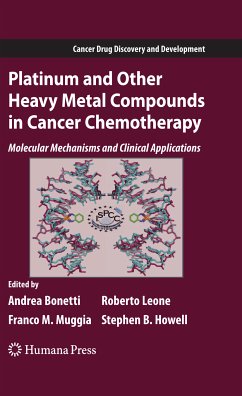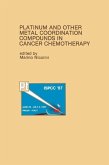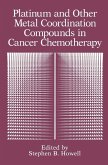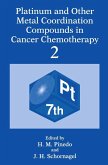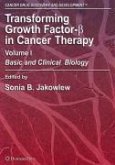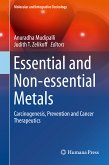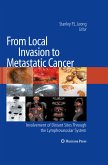Platinum and Other Heavy Metal Compounds in Cancer Chemotherapy (eBook, PDF)
Molecular Mechanisms and Clinical Applications
Redaktion: Bonetti, Andrea; Howell, Stephen B.; Muggia, Franco; Leone, Roberto


Alle Infos zum eBook verschenken

Platinum and Other Heavy Metal Compounds in Cancer Chemotherapy (eBook, PDF)
Molecular Mechanisms and Clinical Applications
Redaktion: Bonetti, Andrea; Howell, Stephen B.; Muggia, Franco; Leone, Roberto
- Format: PDF
- Merkliste
- Auf die Merkliste
- Bewerten Bewerten
- Teilen
- Produkt teilen
- Produkterinnerung
- Produkterinnerung

Hier können Sie sich einloggen

Bitte loggen Sie sich zunächst in Ihr Kundenkonto ein oder registrieren Sie sich bei bücher.de, um das eBook-Abo tolino select nutzen zu können.
The platinum-containing chemotherapeutic agents remain key components of many of the most effective regimens for the treatment of cancer. New information about the chemistry, pharmacology and molecular mechanisms by which these drugs work is leading to both the development of new drugs and more effective use of existing members of this class. Better definition of the genetic basis of malignancies is offering intriguing new insights in to how to use these drugs in a more individualized manner. " Platinum and Other Heavy Metal Compounds in Cancer Chemotherapy: Molecular Mechanisms and Clinical…mehr
- Geräte: PC
- ohne Kopierschutz
- eBook Hilfe
- Größe: 6.66MB
![Platinum and Other Metal Coordination Compounds in Cancer Chemotherapy (eBook, PDF) Platinum and Other Metal Coordination Compounds in Cancer Chemotherapy (eBook, PDF)]() Platinum and Other Metal Coordination Compounds in Cancer Chemotherapy (eBook, PDF)233,95 €
Platinum and Other Metal Coordination Compounds in Cancer Chemotherapy (eBook, PDF)233,95 €![Platinum and Other Metal Coordination Compounds in Cancer Chemotherapy (eBook, PDF) Platinum and Other Metal Coordination Compounds in Cancer Chemotherapy (eBook, PDF)]() Platinum and Other Metal Coordination Compounds in Cancer Chemotherapy (eBook, PDF)233,95 €
Platinum and Other Metal Coordination Compounds in Cancer Chemotherapy (eBook, PDF)233,95 €![Platinum and Other Metal Coordination Compounds in Cancer Chemotherapy 2 (eBook, PDF) Platinum and Other Metal Coordination Compounds in Cancer Chemotherapy 2 (eBook, PDF)]() Platinum and Other Metal Coordination Compounds in Cancer Chemotherapy 2 (eBook, PDF)161,95 €
Platinum and Other Metal Coordination Compounds in Cancer Chemotherapy 2 (eBook, PDF)161,95 €![Transforming Growth Factor-Beta in Cancer Therapy, Volume I (eBook, PDF) Transforming Growth Factor-Beta in Cancer Therapy, Volume I (eBook, PDF)]() Transforming Growth Factor-Beta in Cancer Therapy, Volume I (eBook, PDF)161,95 €
Transforming Growth Factor-Beta in Cancer Therapy, Volume I (eBook, PDF)161,95 €![Essential and Non-essential Metals (eBook, PDF) Essential and Non-essential Metals (eBook, PDF)]() Essential and Non-essential Metals (eBook, PDF)113,95 €
Essential and Non-essential Metals (eBook, PDF)113,95 €![Personalised Medicine (eBook, PDF) Personalised Medicine (eBook, PDF)]() Personalised Medicine (eBook, PDF)121,95 €
Personalised Medicine (eBook, PDF)121,95 €![From Local Invasion to Metastatic Cancer (eBook, PDF) From Local Invasion to Metastatic Cancer (eBook, PDF)]() From Local Invasion to Metastatic Cancer (eBook, PDF)161,95 €
From Local Invasion to Metastatic Cancer (eBook, PDF)161,95 €-
-
-
Dieser Download kann aus rechtlichen Gründen nur mit Rechnungsadresse in A, B, BG, CY, CZ, D, DK, EW, E, FIN, F, GR, HR, H, IRL, I, LT, L, LR, M, NL, PL, P, R, S, SLO, SK ausgeliefert werden.
- Produktdetails
- Verlag: Humana Press
- Seitenzahl: 398
- Erscheinungstermin: 9. Januar 2009
- Englisch
- ISBN-13: 9781603274593
- Artikelnr.: 37361443
- Verlag: Humana Press
- Seitenzahl: 398
- Erscheinungstermin: 9. Januar 2009
- Englisch
- ISBN-13: 9781603274593
- Artikelnr.: 37361443
- Herstellerkennzeichnung Die Herstellerinformationen sind derzeit nicht verfügbar.
